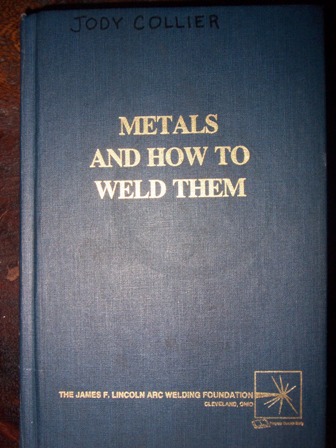"Metals and How to Weld Them" is The best Welding Book for the money
Not what you searched for? Try this Search Tool.

Custom Search
"the James F Lincoln Foundation has some great books for cheap "

Metals and how to weld them…
First things first.
If you don’t have it yet, I would strongly recommend getting the book “Metals and How to Weld Them” (Second Edition) Written by by T.B. JEFFERSON and GORHAM WOODS
you can get a copy for only 10-15 bucks at this link
click here for metals and how to weld them book
Metals and how to weld them…
The Lincoln Welding foundation is a best kept secret, and I thought you would like to know about it.Its a "not for profit" company that offers welding resources like “Metals and How to weld them” as well as other books with plans for welding projects and plenty of other inexpensive welding books.
This video page is the beginning of a series called metals and how to weld them and is about all different metals and the properties of metals.
In this series, We will also cover :
• carbon and low alloys steels
• Stainless steels
• Nickel alloys
• Aluminum alloys
• Magnesium alloys
• Titanium alloys
• Cobalt alloys
• Copper alloys
If you tune in for the whole series you will have a good grasp on what metals are used for what and why.
Carbon and low alloy steels
The most important thing to know about welding carbon and low alloy steels is that if there is enough carbon present, heating and quenching will harden the metal…maybe even make it brittle. So with that in mind lets talk about carbon steels and the difference between low, medium, and high carbons steels.
Carbon steel can be divided into 3 categories …there are sources that further divide carbon steel, but for our discussion, these 3 will do.
Low carbon steel contains from 0-.0.29% carbon
Medium carbon steel contains from 0.30--0.59% carbon
High carbon steel contains more than 0.6% carbon
Low carbon steel can be seen all over in car bodies, structures like bridges, sign posts, etc
Medium carbon steel is used for forging products that require more strength and or hardness than can be cold worked out of low carbon steel
High carbon steel is used for tools, tool and die, molds, springs, cutting tools, etc.
The more carbon, the more potential for hardening and for giving problems during and after welding from brittleness.
One of the more commonly known low alloy steels is 4130 chromoly because it is widely used in motorsports, and in general aviation.
Low alloy steels contain carbon as well as other elements like chromium, molybdenum, and nickel to achieve a certain level of strength, hardness, toughness, and ability to withstand repeated cycles of loading.
4130, 4340, and 4140, all require preheating for successful welding if the metal is over a certain thickness..(around 0.100”--0.120” or 3mm)
Cast Iron is the extreme example I like to used to illustrate the effects of welding on medium or high carbon steel, or a low alloy steel.
While 1020 steel only contains 0.2% carbon, cast irons contain 10 times that much…a full 2-3% carbon content is not uncommon for certain grades of cast iron…that’s enough to make it really hard and brittle when it is heated and cooled.
That’s why a preheat is almost always needed for welding cast iron.
In the video on this page, I show how puddling a small area on cast iron is a good test to verify if it is indeed cast iron…or at least if the part is going to harden from welding.
It’s a good test to let you know what you are in for.
Over the years, I have fielded lots of questions about quoting welding jobs on all kinds of different equipment.
I have advised people to do this simple puddling test when asked to weld on backhoe parts, automotive castings, antiques, etc, and it often saves a lot of headache by knowing when a preheat is needed…or even when to turn down a welding job...sometimes saying no can be the best option.
next in the metals and how to weld series is properties of stainless


















